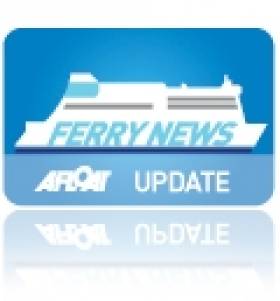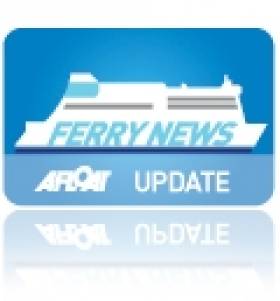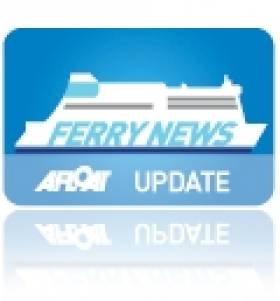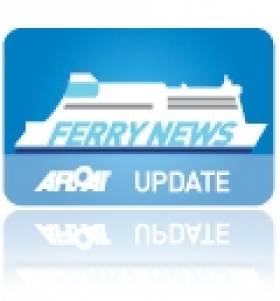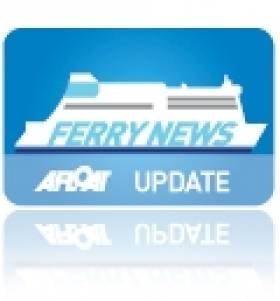Displaying items by tag: Seatruck Ferries
Seatruck Newbuild Making Progress On Irish Sea
#FERRY NEWS -Seatruck Ferries newbuild freight-only ferry, Seatruck Progress carried out berthing trials in Dublin Port yesterday in preparation to her debut on the Liverpool route over the festive period, writes Jehan Ashmore.
This was the inaugural call to the capital, though she had sailed across Dublin Bay earlier this month (as previously reported - click HERE) during her delivery voyage to Liverpool from German shipbuilders FGS Flensburger.
At 142 metres long and with a beam of 24 metres, the four decked ro-ro vessel, offers more capacity to the routes existing pair of 'Point' class vessels, as she can handle an extra 35 trailer units (each of 13.5m) than the Clipper Point and Clipper Pennant.
In February, the newcomer's second sister out of four on order, Seatruck Power is set to join her on the central corridor route.
Seatruck are the only Irish Sea operator dedicated to the carriage of un-accompanied freight traffic, though the vessels can cater for driver accompanied units with a limited number of cabins.
Seatruck Newbuild Makes a Fleeting Appearance
#FERRY NEWS-Seatruck Progress (5,300 dwt) the new freight-only ro-ro, due to enter Seatruck Ferries Dublin-Liverpool service this month, as previously reported on Afloat.ie, sailed past Dublin Bay on Tuesday. She continued her overnight delivery voyage to arrive in Liverpool yesterday, fresh from German builders, FGS Flensburg, writes Jehan Ashmore.
As the newbuild approached Dublin Bay, she set a course to the east of the Burford Bank buoys where she continued her voyage to Liverpool, entering the Bootle docks through Langton Lock.
The Douglas registered ro-ro is to be joined by her fleetmate, Seatruck Power on the central corridor service next February. Each of the 21-knot quartet measure 142m long, have a beam of 24m and cater for 2,166 lane freight-metres with the use of an added upper fourth deck.
The increased capacity will enable un-accompanied trailer units to reach 70 on each of the sailings, which are currently served by smaller 'P' series ro-ro's Clipper Point and Clipper Pennant. These vessels were also commissioned by Seatruck from Spanish shipyards and entered servvice several years ago.
Seatruck which is a subsidiary of the Danish-owned Clipper Group, is set to expand the fleet as the Irish Sea's only freight-only operator with a futher pair of the same class from FGS, which are due for delivery in the first-half of 2012. According to Seatruck, these newbuilds are likely to be deployed on the company's other Irish Sea routes.
Seatruck's New Freight-Ferry on Delivery Voyage
#FERRY NEWS-Seatruck Progress (photo), the first of two 18,900 gross tonnes ro-ro newbuilds due to enter on Seatruck Ferries Dublin-Liverpool route, is en -route in the English Channel today from German builders, FGS Flensburg, writes Jehan Ashmore.
Her sister Seatruck Power is due to join her fleetmate on the central corridor service by mid-February. In addition Seatruck have on order another pair of the same class from FGS which are to be completed in 2012 and are likely to be deployed on the company's other Irish Sea routes.
The new quartet each measure 142m and will offer 2,166 lane freight-metres spread over four decks. They will each have a capacity of 150 units, 35 more than Seatruck's current P Series vessels in which Clipper Point and Clipper Pennant are currently employed on the route.
The company operate 80 sailings per week on four routes: Dublin-Liverpool,Dublin- Heysham, Warrenpoint-Heysham and Larne-Heysham. The newbuilds will also be the largest vessels ever to operate out of Heysham.
In the last two years freight volumes doubled and Seatruck has 20% of the Irish Sea market as against 3.7% in 2004. This year Seatruck will ship 300,000 units on the Irish Sea and with the fleet expansion this total will grow substantially in 2012.
Seatruck’s New Freight-Ferry to Make December Debut
Seatruck, which claims 20% of the Irish Sea market compared to just 3.7% in 2004, says it will transport 300,000 units in 2011 on its four routes: Dublin-Liverpool, Dublin-Heysham, Warrenpoint-Heysham and Larne-Larne. With the introduction of the newer larger vessels, Seatruck is aiming at the 45% of Irish Sea freight market that is still driver-accompanied.
Alistair Eagles, MD of Seatruck (Irish Sea) says that his company's share of unaccompanied freight volumes is set to grow in 2012, although the total Irish Sea ro-ro market is set to remain static next year, but better than a 1% decline in 2011.
Mr Eagles said: "We believe that our sector of the market — freight-only unaccompanied — will continue to grow. By offering pure freight services we can keep the costs down relatively lower compared with the combined passenger and freight ferry operators.
"We are seeing a switch away from driver-accompanied shipments because hauliers can save quite a lot of money."
Seatruck also benefited from a radical shake-up on the Irish Sea ferry market, with largescale withdrawals of capacity by DFDS and other changes, notably taking over the Dublin-Heysham route in February, to read more click HERE. The route is served by the chartered 120-unit Anglia Seaways which has accommodation for 12 drivers.
As for the remaining newbuild pair, they are scheduled for delivery from FGS during the first half of 2012 and deployed on yet-to-be announced routes. Like the new quartet, the same number were ordered of the 'P' class which entered service from 2008 onwards which included Clipper Pace and Clipper Panorama which currently operate 22 weekly sailings on the Warrenpoint-Heysham route.
Seatruck also operate Clipper Ranger and Arrow on Larne-Heysham sailings, where they each provide a capacity of 65 units and offer driver accompanied traffic with accommodation in en-suite cabins.
The older sisters will both be replaced when the second newbuild Seatruck Power (for previous report click HERE) comes on stream in mid-February 2012.
{youtube.com}=90b-c1j0S_E{/youtube.com}
Launching of M.V. Seatruck Power at FGS, Germany
Seatruck, which claims 20% of the Irish Sea market compared to just 3.7% in 2004, says it will transport 300,000 units in 2011 on its four routes: Dublin-Liverpool, Dublin-Heysham, Warrenpoint-Heysham and Larne-Larne. With the introduction of the newer larger vessels, Seatruck is aiming at the 45% of Irish Sea freight market that is still driver-accompanied.
Alistair Eagles, MD of Seatruck (Irish Sea) says that his company's share of unaccompanied freight volumes is set to grow in 2012, although the total Irish Sea ro-ro market is set to remain static next year, but better than a 1% decline in 2011.
Mr Eagles said: "We believe that our sector of the market — freight-only unaccompanied — will continue to grow. By offering pure freight services we can keep the costs down relatively lower compared with the combined passenger and freight ferry operators.
"We are seeing a switch away from driver-accompanied shipments because hauliers can save quite a lot of money."
Seatruck also benefited from a radical shake-up on the Irish Sea ferry market, with largescale withdrawals of capacity by DFDS and other changes, notably taking over the Dublin-Heysham route in February, to read more click HERE. The route is served by the chartered 120-unit Anglia Seaways which has accommodation for 12 drivers.
As for the remaining newbuild pair, they are scheduled for delivery from FGS during the first half of 2012 and deployed on yet-to-be announced routes. Like the new quartet, the same number were ordered of the 'P' class which entered service from 2008 onwards which included Clipper Pace and Clipper Panorama which currently operate 22 weekly on Warrenpoint-Heysham sailings.
Seatruck also operate Clipper Ranger and Arrow on Larne-Heysham sailings where they each provide a capacity of 65 units and offer a limited number of driver accompanied traffic accommodation in en-suite cabins.
Stena Superfast VII Departs Poland for New Belfast-Cairnryan Route

The New Superfast leaves Gdansk
The 30,285grt newcomer and her sister Stena Superfast VIII will become the largest ever ferries running on the North Channel , though prior to entering service on 21 November, they will undertake berthing trials and crew training.
For the next two-years the sisters are on charter from Scandinavian operators Tallink, and are to operate the new 2 hour 15 minute route with 12 crossings daily. The ten-deck ships can carry up to 1200 passengers, 660 cars or 110 freight units. The sisters will be re-gistered in their new homport of Belfast.
The relocation of Scottish ferry port and the introduction of the Superfast sisters will replace the existing pair of conventional ferry tonnage, Stena Caledonia and Stena Navigator (1984/15,229gt) the latter vessel is believed to be sold. In addition HSS sailings will cease causing the HSS Stena Voyager to become redundant, she was the second of the trio of pioneering HSS 1500 craft built.
When Stena Superfast VII departed Gdansk, she passed the Stena Vision which operates Stena Line's Karlskrona-Gdynia route, the Baltic Sea city lies to the west of Gdansk. Also in Gdansk was the Stena Feronia, the former Irish Sea serving Visentini built ro-pax Dublin Seaways, which was operated albeit briefly by DFDS Seaways last year on the Dublin-(Birkenhead) Liverpool service.
She served under her new Scandinavian owners but the firm's first foray into the Irish market lasted a mere six months. DFDS Seaways sold their Irish Sea network to Stena Line (to read report click HERE) with the exception of their Dublin-Birkenhead service which closed. In addition the Dublin-Heysham freight-only route which closed until re-opened by Seatruck Ferries. The route is currently served by Anglia Seaways, the freightferry which DFDS previously used on the route is on charter to the operator.
- DFDS Seaways
- Baltic Sea
- Stena Line
- Ports and Shipping News
- Seatruck Ferries
- North Channel
- Stranraer
- Dublin Seaways
- Ferry news
- Tallink
- Loch Ryan Port
- HSS Stena Voyager
- Stena Caledonia
- Stena Navigator
- Belfast Lough News
- HSS
- Visentini ropax
- BelfastCairnryan
- Stena Superfast VII
- Stena Superfast VIII
- Stena Superfast
- Superfast Sisters
- North Channel ferry routes
- Stena Feronia
- LRP
- BirkenheadBelfast
- DublinBirkenhead
Seatruck Ferries Second Ro-Ro Newbuild Launched
The remaining pair are due for delivery in June 2012 from the German shipbuilder Flensburger Schiffbau-Gesellschaft (FSG) located on the Baltic Sea, close to the Danish border.
Seatruck Ferries is a division of the Danish shipping giant Clipper Group, which operates four routes in the north Irish Sea. The company offer 80 sailings per week on four routes: Dublin-Heysham, Dublin-Liverpool, Warrenpoint-Heysham and Larne- Heysham.
First Heysham-Max Newbuild Launched for Seatruck Ferries
The quartet of Heysham-Max class vessels are the largest ever vessels built to operate from the Cumbrian port which has determined the length of the new ships. Despite the restrictions imposed by the dimensions of the port, the optimum cargo-load of the newbuilds were achieved by positioning the deckhouse forward so to guarantee un-hampered loading of the upper decks.
Propulsion is from two MAN 7L48/60CR main engines of 2 x 8,000kW providing 21 knots. The powerplant is designed to meet rigorous emission and fuel consumption demands, according to FSG managing director Peter Sierk.
Seatruck Sailings Start on Dublin-Heysham Route
The vessel has accommodation for 12 drivers. Most of the daily sailings depart Dublin at 15:15hrs and return from the Lancashire port at 02:15hrs. On certain days the schedules vary, to view the timetable click here.
In addition to the new route for Seatruck Ferries, the freight-only operator has a fleet of 8 vessels on routes between Dublin-Liverpool, Warrenpoint-Heysham and Larne-Heysham.
Anglia Seaways arrived into Dublin yesterday morning from Avonmouth Docks, where the 120 unit capacity vessel went into temporary lay-up period, since departing the Irish capital on 31 January (see related posting and photo).
The 13,073grt vessel revived the 8-hour route yesterday with an afternoon sailing bound for Heysham. The vessel was originally reported to be relocated to Baltic Sea operations, but with its charter to Seatruck, the DFDS Seaways funnel symbol of the Maltese cross was painted out.
Though, the Maltese cross can still be seen in Irish ports with calls made by sisterships, Dana Gothia (ex. Maersk Westland) and Dana Hollandia (formerly Maersk Waterford) which are part of the DFDS Group container subsidiary DFDS Logistics.
In total the Lo-Lo shipping division operates four vessels on several routing options with weekly calls to Belfast, Dublin, Cork and Waterford to Rotterdam and Zeebrugge.
The German built sisters originally operated Dublin-Rotterdam and Waterford-Rotterdam routes for Norfolk Line (a subsidiary of Maersk / A.P. Moller Group).Incidentally Maersk /Norfolkline also owned the Anglia Seaways until DFDS Seaways purchased the vessel last year.
Seatruck to Re-Open Dublin-Heysham Route
Seatruck Ferries is to re-open the Dublin-Heysham route following the closure by DFDS Seaways of the freight-only service last month, writes Jehan Ashmore.
The first sailing of the revived route is scheduled to depart Heysham next Monday at 02.00hrs and the corresponding departure from Dublin is at 14.00hrs. Seatruck have yet to release the identity of the one-ship operated service, previously run by DFDS Anglia Seaways.
Seatruck decided to re-open the route based on strong demand and of the firm commitment to support the service from several road haulage firms.
To facilitate the additional business of the new route, Seatruck's existing use of Terminal 3 for its Dublin-Liverpool service will no longer be required. Instead all operations will be centred at Terminal 5, previously used by DFDS Seaways for their freight and passenger ferry vessels on the Heysham and Liverpool (Birkenhead) routes.
The company which is part of the Bahamas based Clipper Group Ltd (which controls 250 vessels) also operate between Warrenpoint-Heysham and Larne-Heysham. Seatruck operate an eight–strong Irish Sea fleet, which include four new vessels that were built in Spain and introduced onto two of their routes since 2008.
Lead-ship of the four 120-trailer capacity vessels, Clipper Point was followed by Clipper Panorama on the Warrenpoint route. The Clipper Pace and the final unit of the quartet, Clipper Pennant, serve on the Liverpool route. The new Dublin-Heysham route will increase the total number of all Seatruck route sailings to 80 each week.





























